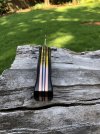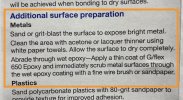Hello Everyone;
So here are my materials and the order in which they are sandwiched.
-Desert Iron Wood
-G10
-Copper
-G10
-African Blackwood
I'd attempted glue up with G Flex and Gorilla Glue Tough Epoxy and during sawing or finishing the copper has delaminated.
My Process
-Square all surfaces in the mill
-Cut all parts and rough mating surfaces with 60 grit
-Apply epoxy to all surfaces and clamp, let sit for 24 hours minimum
I make one large block and rip it up the middle with the bandsaw, the failure usually comes during that cut but not always. I had a close to finished handle scale let go at the copper mating surface yesterday.
I was assuming the issue was the thermal conductivity of copper so I tried the same process with 416 stainless and went slowly, with very little heat rise the same delamination happened.
Questions;
1) Do most of you typically start with one block and rip the block in half?
2) If not #1 what is your process?
3) Would it be more prudent to just make individual scales to start with instead of ripping a large block?
Comments:
-I seems like I am missing a chapter here, I would prefer not to pin all of the components together as that is an extra step.
-This only occurs with handle scales, when I am doing something very similar with hidden tang handles (Wa specifically) I have had zero issues but I suspect that the lack of bandsaw usage may help
-I am not concerned about matching scale or anything
-A bit of guidance would be appreciated as I have wasted a great deal of wood and copper in the process
So here are my materials and the order in which they are sandwiched.
-Desert Iron Wood
-G10
-Copper
-G10
-African Blackwood
I'd attempted glue up with G Flex and Gorilla Glue Tough Epoxy and during sawing or finishing the copper has delaminated.
My Process
-Square all surfaces in the mill
-Cut all parts and rough mating surfaces with 60 grit
-Apply epoxy to all surfaces and clamp, let sit for 24 hours minimum
I make one large block and rip it up the middle with the bandsaw, the failure usually comes during that cut but not always. I had a close to finished handle scale let go at the copper mating surface yesterday.
I was assuming the issue was the thermal conductivity of copper so I tried the same process with 416 stainless and went slowly, with very little heat rise the same delamination happened.
Questions;
1) Do most of you typically start with one block and rip the block in half?
2) If not #1 what is your process?
3) Would it be more prudent to just make individual scales to start with instead of ripping a large block?
Comments:
-I seems like I am missing a chapter here, I would prefer not to pin all of the components together as that is an extra step.
-This only occurs with handle scales, when I am doing something very similar with hidden tang handles (Wa specifically) I have had zero issues but I suspect that the lack of bandsaw usage may help
-I am not concerned about matching scale or anything
-A bit of guidance would be appreciated as I have wasted a great deal of wood and copper in the process





